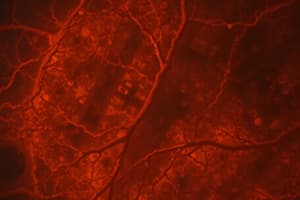Podcast
Questions and Answers
What is the primary characteristic of RPE hyperplasia?
What is the primary characteristic of RPE hyperplasia?
- Associated with hereditary retinopathies
- Production of hyperreflective signals
- Presence of distinct margins (correct)
- Accompanied by retinal detachment
In the context of acquired RPE hyperplasia, what does the term 'jet black to light black' primarily describe?
In the context of acquired RPE hyperplasia, what does the term 'jet black to light black' primarily describe?
- The extent of choroidal involvement
- The reflective properties in OCT
- The size of hyperplastic lesions
- The color of the pigment in RPE hyperplasia (correct)
Which clinical intervention is specifically related to the treatment of Choroiditis?
Which clinical intervention is specifically related to the treatment of Choroiditis?
- Laser retinopexy
- Intravitreal injections
- Surgical vitrectomy
- Laser photocoagulation (correct)
What is a common result of RPE hyperplasia following an inflammatory condition?
What is a common result of RPE hyperplasia following an inflammatory condition?
What type of imaging might show hyperreflective signals related to choroidal conditions?
What type of imaging might show hyperreflective signals related to choroidal conditions?
What is the characteristic arrangement of pigment irregularity in reticular degeneration?
What is the characteristic arrangement of pigment irregularity in reticular degeneration?
What is the prevalence of reticular degeneration in adults over the age of 40 years?
What is the prevalence of reticular degeneration in adults over the age of 40 years?
What is the typical location of reticular degeneration?
What is the typical location of reticular degeneration?
What is the histological characteristic of reticular degeneration?
What is the histological characteristic of reticular degeneration?
What is the appearance of pavingstone degeneration?
What is the appearance of pavingstone degeneration?
What is the typical location of pavingstone degeneration?
What is the typical location of pavingstone degeneration?
What is the frequency of bilaterality in pavingstone degeneration?
What is the frequency of bilaterality in pavingstone degeneration?
What is the symptomatology of pavingstone degeneration?
What is the symptomatology of pavingstone degeneration?
What characterizes pavingstone degeneration in terms of its coloration?
What characterizes pavingstone degeneration in terms of its coloration?
Which of the following is NOT a characteristic of congenital hypertrophy of the retinal pigment epithelium (CHRPE)?
Which of the following is NOT a characteristic of congenital hypertrophy of the retinal pigment epithelium (CHRPE)?
What is observed in the histological examination of pavingstone degeneration?
What is observed in the histological examination of pavingstone degeneration?
What kind of lesion is typically associated with congenital hypertrophy of RPE?
What kind of lesion is typically associated with congenital hypertrophy of RPE?
Which statement about pavingstone degeneration is true?
Which statement about pavingstone degeneration is true?
Which of the following descriptions is true regarding the pigment in CHRPE?
Which of the following descriptions is true regarding the pigment in CHRPE?
Which condition is a rare association with familial adenomatous polyposis in Gardner’s syndrome?
Which condition is a rare association with familial adenomatous polyposis in Gardner’s syndrome?
How are the borders of CHRPE lesions typically described?
How are the borders of CHRPE lesions typically described?
Flashcards are hidden until you start studying
Study Notes
Reticular Degeneration
- Characterized by irregular pigment in a honeycomb or reticular pattern.
- Affects retinal pigment epithelium (RPE) near the equator.
- Occurs in approximately 20% of adults over 40 years old.
- Typically bilateral, affecting nasal quadrants.
- Usually asymptomatic and considered benign.
- Histological features include:
- Diminished choriocapillaris.
- Thickened Bruch's membrane.
- Loss of melanin granules from RPE.
- Reduction in some photoreceptor cells.
- Not all histological changes are present simultaneously.
Pavingstone (Cobblestone) Degeneration
- Features solitary or multifocal round, punched-out lesions.
- Lesions located between ora serrata and equator, more prevalent in inferior quadrants.
- Often bilateral and increasingly common with age.
- Generally benign and asymptomatic.
- Appearance may be visually dramatic.
- Histological characteristics include:
- Ischemic atrophy of choriocapillaris.
- Subsequent loss of RPE and photoreceptors.
- Lesions appear yellow-whitish due to sclera visibility through atrophic choroid.
Congenital Hypertrophy of RPE (CHRPE)
- Presents as dark or black flat lesions.
- Can be unilateral, bilateral, solitary, or multifocal.
- Characterized by enlarged RPE cells packed with melanin granules.
- Rare association with familial adenomatous polyposis (Gardner’s syndrome).
- Generally a common benign condition in which RPE cells enlarge without becoming malignant.
- Borders of lesions are well-defined; patients are typically asymptomatic.
- Lesions may progress but malignancy is unlikely.
- Lacunae may form, presenting as small atrophic areas within the degeneration.
RPE Hyperplasia
- Can result from post-inflammatory events such as uveitis, retinitis, and choroiditis.
- Iatrogenic factors include procedures like laser retinopexy and laser photocoagulation.
- Also associated with trauma and hereditary retinopathies.
- Represents a scar-like reaction to inflammatory conditions.
- Similar presentation in both congenital CHRPE and acquired RPE hyperplasia, characterized by flat lesions that vary in color from jet black to light black with distinct margins.
Studying That Suits You
Use AI to generate personalized quizzes and flashcards to suit your learning preferences.




